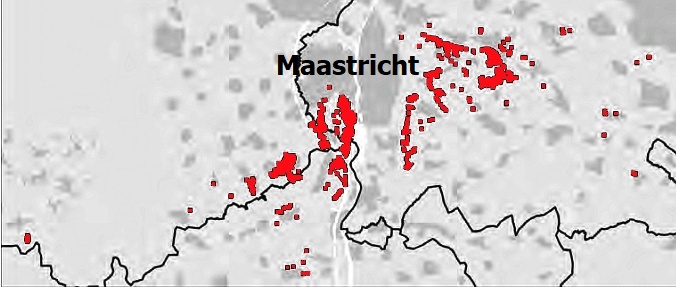About the SOK (Studygroup Subterranean Limestone Quarries)
Our members have been studying subterranean limestone quarries (also called "marl caves") since 1977, mainly in the Netherlands and Belgium, with occasional trips to other countries as well.
A core task is to perform and promote research into subterranean limestone quarries and publish the results in our magazines. There are also regular excursions and organised courses.
Six times per year we organize a lecture in the Natural History Museum Maastricht, non-members are also welcome.
Please note that both our publications and events are purely in the Dutch language.
Our primary focus lies on the history of the local subterranean limestone quarries, flint mines and sometimes open pit mines. In total there are about 500 quarries in the vincity of Limburg and Wallonia. Other fields of study are the various techniques and tools used. The quarrying commenced ± 1160 and lasted until ± 1960 (only one quarry still active to gain blocks for restoration purposes). In addition, our study concerns geology and fossils, cartography, the secondary use of the quarries (such as the cultivation of mushrooms, tourism, shelters) and living nature such as bats and insects. Attention is also paid to the preservation of the cultural heritage for future generations, as the underground quarries have been endangered for over 100 years do to extensive industrial excavations. For instance: The subterranean complex underneath mount St. Peter near Maastricht used to be the largest in the world until the 20th century, measuring over 150 hectares (370 acres), however about 75% has disappeared in open-pit quarries like cement factory ENCI. Of the remaining part only 10% is currently accessible, the rest is lost due to collapses (or off limits due to risk thereof).
Guided tours take place since at least the 17th century, showing visitors the underground drawings, sculptures and handwritings. It was often referred to as a modern wonder of the world.
A special field of study are the thousands of handwritings on the walls in our quarries, from locals to famous people like Napoleon (1803), the Duke of Alva (Don Alvarez de Toledo, 1570), Czar Peter the Great (1717), The Dutch Queen (1903), Sir Walter Scott, Friedrich Fröbel, British Volunteers and American soldiers in WW2. The oldest handwritings found date back to 1440, 1457 and 1468.
In case that you, as a foreign visitor, would like to receive additional information please don't hesitate to contact us. Especially inquiries from other researchers are always welcome.

Important note: almost all quarries are locked and off limits to visitors. Illegal visitors may get a fine of 300 Euro if caught by a forest guard.
About 15 quarries offer tours for groups and tourists, like
subterranean mount St. Peter.


